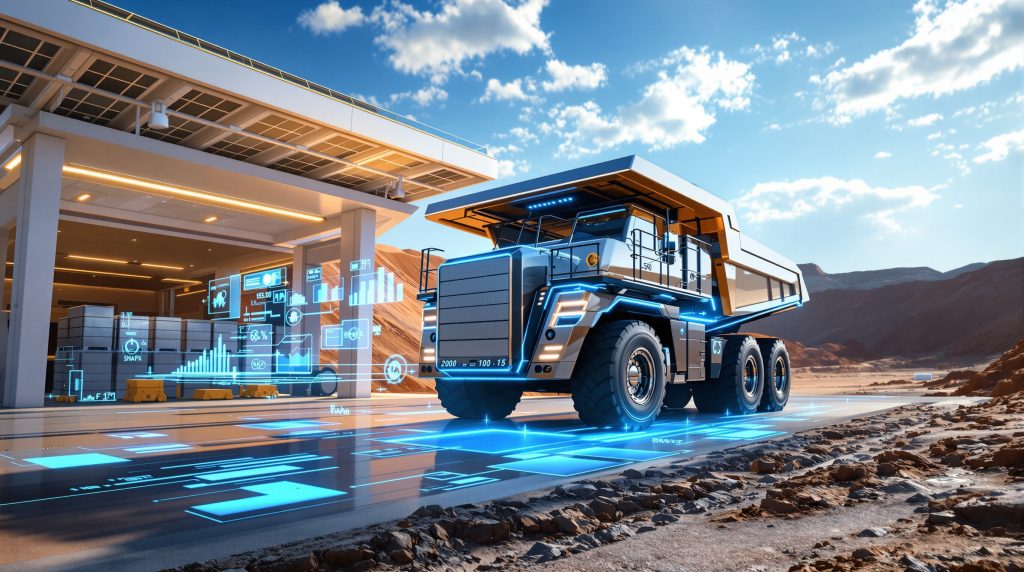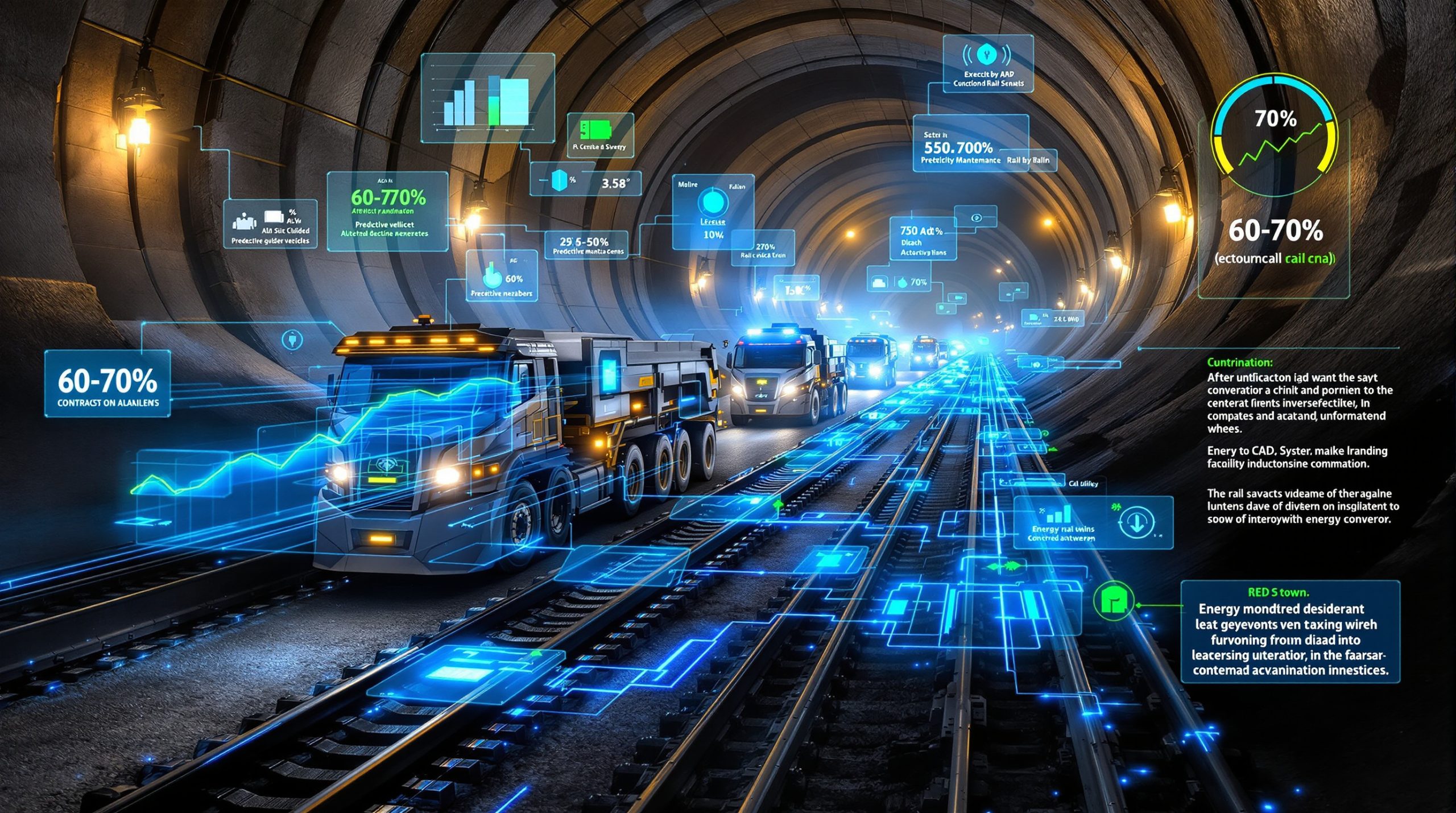Revolutionary Mining Technology Emerges
Battery swap electric haul trucks represent a transformative approach to mining electrification, utilising rapid battery exchange systems to eliminate the operational constraints of traditional charging methods. This technology enables complete battery replacement in under ten minutes, maintaining continuous fleet operations whilst delivering zero-emission performance across mining sites. Furthermore, these innovations align with broader mining industry evolution trends focused on sustainability and operational efficiency.
The core innovation lies in automated swap stations that house multiple battery packs, allowing trucks to exchange depleted batteries for fully charged units without extended downtime. Unlike conventional electric vehicles requiring hours of stationary charging, these systems maintain productivity schedules comparable to diesel operations whilst achieving complete electrification. Moreover, data-driven mining operations increasingly integrate these technologies for optimised performance monitoring.
Advanced System Architecture
Modern battery swap systems integrate sophisticated components working in coordination to optimise mining operations:
| Component | Primary Function | Technical Specifications |
|---|---|---|
| Modular Battery Pack | Energy storage and delivery | 500-1000 kWh capacity range |
| Automated Exchange Station | Rapid battery replacement | 3-7 minute swap duration |
| Fleet Management System | Real-time monitoring and optimisation | Predictive maintenance tracking |
| Grid Interface Module | Energy distribution management | Load balancing capabilities |
The battery packs utilise advanced lithium chemistries specifically engineered for high-cycle applications. Additionally, thermal management systems ensure stable performance across extreme temperature ranges from -30°C to +50°C. Consequently, AI-driven maintenance insights further enhance system reliability through predictive analytics.
Addressing Critical Mining Electrification Challenges
Traditional electric mining trucks face three fundamental obstacles that battery swapping technology directly addresses through innovative engineering solutions. Extended charging periods of 4-8 hours create significant operational disruptions, whilst oversized permanent battery installations reduce payload capacity and increase infrastructure complexity.
Eliminating Operational Downtime
The swap process fundamentally changes mining economics by converting fixed charging time into brief service intervals. Operations can maintain 24/7 productivity schedules whilst achieving complete electrification, with swap stations functioning as energy management hubs that optimise charging during off-peak grid periods.
Battery swap stations serve dual purposes as operational infrastructure and energy management systems, reducing operational costs by up to 30% through intelligent load distribution and peak shaving capabilities.
Optimising Payload Performance
Mission-specific battery sizing rather than oversized permanent installations allows trucks to maximise cargo capacity whilst maintaining required operational range. This approach directly addresses the mining industry's primary concern regarding electric vehicle weight penalties, with optimised systems improving payload capacity by 5-15% compared to conventional electric alternatives.
Breakthrough Deployment at Oyu Tolgoi
Rio Tinto's collaboration with China's State Power Investment Corporation (SPIC) Qiyuan at the Oyu Tolgoi copper mine represents the largest-scale validation of battery swap technology in surface mining operations. According to reporting on October 26, 2025, the deployment includes eight 91-tonne trucks with 13 batteries and supporting infrastructure including static chargers.
The trial, scheduled throughout 2026, focuses on tailings dam construction and topsoil transportation tasks. Furthermore, it provides comprehensive operational data for scaling the technology across global mining operations. Rio Tinto General Manager Ben Woffenden stated that rapid deployment and fast-tracked operational learnings highlight the importance of partnerships in advancing low-emission haulage alternatives.
Performance Validation Metrics
Current implementations demonstrate the technology's progression from experimental trials to commercial viability:
| Project Location | Fleet Configuration | Vehicle Capacity | Exchange Duration | Battery Technology |
|---|---|---|---|---|
| Oyu Tolgoi, Mongolia | 8 trucks, 13 battery packs | 91 tonnes | Under 7 minutes | Advanced lithium systems |
| European Highway Trials | Multiple configurations | Variable capacities | Under 10 minutes | LFP technology |
| Underground Operations | 3-5 vehicle fleets | 50 tonne class | Approximately 3 minutes | LTO chemistry |
The Mongolian deployment provides critical data on battery performance in extreme weather conditions. Temperatures range from -40°C in winter to +40°C in summer, validating thermal management systems under real-world operational stresses.
Specialised Battery Chemistry Solutions
Battery swap electric haul trucks require chemistries prioritising safety, cycle life, and rapid charge acceptance over energy density. Lithium iron phosphate (LFP) and lithium titanate oxide (LTO) technologies lead this specialised segment due to their robust performance characteristics and enhanced safety profiles.
Safety-Optimised Design Philosophy
Swap-specific battery systems incorporate multiple safety features essential for automated handling operations:
- Thermal stability under extreme operational conditions
- Reduced fire risk during automated handling procedures
- Vibration resistance for dusty, high-impact mining environments
- Predictable failure modes enabling proactive maintenance scheduling
Extended Cycle Life Requirements
Mining applications demand exceptional durability with systems designed for:
- 10,000+ charge-discharge cycles over operational lifetime
- Minimal capacity degradation maintaining performance predictability
- Consistent characteristics enabling accurate fleet planning and logistics
Swap stations incorporate sophisticated battery management systems monitoring individual cell health. Consequently, they optimise charging profiles and predict maintenance requirements. Facilities typically maintain 3-5 battery packs per truck ensuring continuous availability during peak operational periods.
Economic Analysis and Cost Comparison
Financial modelling reveals battery swapping advantages become pronounced in high-utilisation scenarios where downtime costs exceed infrastructure investments. Mining operations with continuous production schedules generating $10,000+ per hour in production value benefit most significantly from this technology.
Total Cost of Ownership Framework
| Economic Factor | Traditional EV Charging | Battery Swap Implementation |
|---|---|---|
| Initial Infrastructure Investment | Lower capital requirement | Higher upfront investment |
| Daily Operational Downtime | 4-8 hours charging periods | Under 10 minutes per cycle |
| Battery Maintenance Impact | Complete vehicle offline | Modular component replacement |
| Grid Infrastructure Demand | High-power connections required | Distributed load management |
| Energy Cost Optimisation | Limited flexibility | Peak/off-peak optimisation |
The technology converts fixed charging costs into variable operational expenses. Additionally, swap stations provide revenue opportunities through grid stabilisation services, renewable energy storage, and demand response capabilities during non-operational periods. These align with broader energy transition strategies across the industry.
Revenue Protection Benefits
For high-value mining operations, even modest downtime reductions justify swap infrastructure investments. The system essentially eliminates productivity losses associated with charging schedules whilst maintaining diesel-equivalent operational flexibility.
Infrastructure Development Requirements
Successful deployment requires coordinated infrastructure development, standardised interfaces, and integrated energy management systems. Current challenges centre on interoperability standards, maintenance complexity, and specialised workforce requirements for high-voltage automated systems.
Critical Standardisation Elements
Industry-wide adoption depends on establishing universal compatibility standards:
- Standardised battery pack dimensions and electrical connections
- Universal swap station interfaces across multiple manufacturers
- Common communication protocols for fleet management systems
- Unified safety procedures and emergency response protocols
Maintenance and Technical Support
Swap stations require specialised maintenance teams trained in:
- High-voltage electrical systems and safety protocols
- Automated handling equipment calibration and repair
- Battery diagnostics and predictive maintenance techniques
- Grid integration systems and energy management optimisation
This creates new skill requirements for mining operations traditionally focused on mechanical systems. Consequently, it necessitates comprehensive training programmes and technical certification pathways.
Global Adoption Patterns and Regional Leadership
Asia-Pacific markets, particularly China, demonstrate the most aggressive deployment of swap-enabled battery swap electric haul trucks. This is driven by government incentives supporting electric fleet adoption and established battery manufacturing supply chains. European operations focus primarily on highway applications with cross-border standardisation initiatives, as seen in recent electric truck trials.
Regional Implementation Strategies
Asia-Pacific Market Leadership:
- Government subsidies supporting zero-emission fleet transitions
- Integrated battery manufacturing and recycling infrastructure
- Regulatory frameworks mandating emission reduction targets
European Integration Approach:
- Cross-border compatibility standardisation programmes
- Renewable energy integration requirements
- Long-haul transportation corridor development focus
North American Pilot Programmes:
- Mining-specific application trials and validation studies
- Infrastructure investment planning and feasibility assessments
- Regulatory framework development for automated systems
Current projections indicate battery swap technology will achieve cost parity with diesel systems by 2027-2028. This is driven by continued battery cost reductions and expanding carbon pricing mechanisms across global markets.
Future Technology Evolution and Integration
Next-generation developments focus on autonomous swap operations, wireless power transfer integration, and predictive maintenance capabilities. Furthermore, these utilise artificial intelligence for optimal battery allocation and energy management optimisation.
Autonomous Operation Capabilities
Second-generation systems will incorporate:
- Fully robotic swap procedures requiring minimal human intervention
- AI-driven battery health optimisation and replacement scheduling algorithms
- Integrated autonomous vehicle navigation for seamless operational coordination
- Predictive maintenance systems utilising machine learning for component lifecycle optimisation
Advanced Energy Management Integration
Future deployments will feature:
- Vehicle-to-grid capabilities during stationary operational periods
- Renewable energy storage and distribution network functions
- Dynamic pricing optimisation for energy procurement and grid services
- Load balancing services supporting regional electrical grid stability
Technology Convergence Opportunities
Battery swap systems will increasingly integrate with renewable energy installations, solar arrays, and wind generation facilities. Consequently, this creates mining operations capable of functioning as net energy exporters during peak production periods whilst maintaining operational independence. Additionally, battery recycling innovations will enhance the circular economy aspects of these systems.
Environmental Impact and Safety Enhancements
Battery swap technology enables mining operations to achieve carbon neutrality whilst maintaining established productivity standards. Environmental benefits extend beyond direct emission reductions to include improved air quality, reduced noise pollution, and elimination of diesel fuel handling risks.
Comprehensive Emission Reduction
| Environmental Metric | Diesel Haul Trucks | Battery Swap Electric Systems |
|---|---|---|
| Annual CO2 Emissions | 50-80 tonnes per vehicle | Zero operational emissions |
| Particulate Matter Release | Significant local air quality impact | Eliminated at point of operation |
| Operational Noise Levels | 85-95 decibels | 65-75 decibels |
| Maintenance Waste Generation | Oils, filters, hydraulic fluids | Recyclable battery materials only |
Enhanced Safety Protocol Implementation
Electric powertrains eliminate explosion risks associated with diesel fuel storage, handling, and transportation across mining sites. Battery swap systems incorporate multiple safety interlocks, automated fire suppression systems, and emergency shutdown procedures ensuring safe operation under all conditions.
Advanced thermal management systems prevent battery overheating during extreme operational conditions. Moreover, automated handling eliminates human exposure to high-voltage components during battery exchange procedures.
Operational Questions and Technical Considerations
How does swap duration compare to traditional refueling?
Current battery swap electric haul trucks complete full exchanges in 3-7 minutes, directly comparable to diesel refuelling operations and significantly faster than traditional electric vehicle charging requirements.
What happens to depleted batteries during operations?
Depleted batteries automatically enter optimised charging cycles at swap stations. Typically, they reach full capacity within 2-4 hours using advanced charging profiles that maximise battery lifespan and performance.
Can systems operate in extreme weather conditions?
Advanced battery management systems maintain consistent performance across temperature ranges from -30°C to +50°C. Integrated thermal management protects battery health and ensures reliable operation.
How does swapping affect vehicle payload capacity?
Optimised battery sizing improves payload capacity by 5-15% compared to oversized permanent installations. This is achieved whilst maintaining required operational range for specific mining applications.
What maintenance requirements do swap facilities have?
Swap stations require weekly operational inspections, monthly system calibration procedures, and quarterly comprehensive maintenance cycles. This is similar to other automated industrial equipment installations.
Disclaimer: This analysis presents current developments in battery swap electric haul truck technology based on publicly available information and industry reports. Future performance projections and cost estimates should be considered speculative and subject to technological, regulatory, and market developments. Investment and operational decisions should be based on comprehensive due diligence and professional consultation.
Want to Capitalise on Mining Technology Breakthroughs?
Discovery Alert's proprietary Discovery IQ model delivers real-time alerts on significant ASX mineral discoveries in the mining technology sector, instantly empowering subscribers to identify actionable opportunities ahead of the broader market. Understand why major mineral discoveries can lead to significant market returns by exploring historic examples of exceptional outcomes and begin your 30-day free trial today to position yourself ahead of the market.




